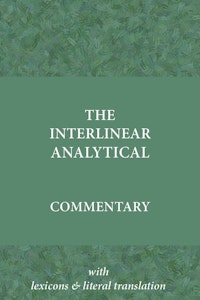
The Interlinear Analytical Commentary
L.W. PierceOnline Bible Canada
The Englishman’s Analytical Bible keyed to Enhanced Strong’s Numbers is an Analytical Interlinear Commentary with Lexicons and a literal translation of the Bible. These study aids give you in-depth-study possibilities directly from the biblical source text.
You can use the powerful possibilities of this Analytical Commentary when you display the Notes in synchronised scrolling mode together with the Bible version (preferable a Bible with Strong’s numbers).
The Analytical Notes give you direct access to the source text, a literal translation, Strongs numbers and grammatical information. The literal translation helps you to understand the orginal text quicker and the Strong’s numbers give the possibility for further study of the meaning of a word. Combine this with the grammatical parsings and you obtain a deeper understanding of the text.
This Analytical Interlinear Commentary gives more detailed information than obtained with a standard Strong’s Lexicon. The disadvantage of the use of a Strong’s Lexicon alone is that you miss the meaning of words in different contexts as well as the differences in meaning in different grammatical settings. The Analytical Interlinear Commentary overcomes this problem.
You can already benefit from this study aid when you have no or limited knowledge of biblical Hebrew and Greek. The Analytical Interlinear Commenatry helps you to obtain more understanding of Greek and Hebrew in its context while you use it.
The Analytical Interlinear Commentary comes with several additional reference works which can be accessed from inside as well as outside this Analytical Interlinear Commentary:
1. Literal: Edition 2025 The (Almost) Literal English Bible Translation with Strong’s Numbers. This translation is extracted from the Analytical Interlinear Commentary. Only the word-order, punctuations and capitalisation is changed to obtain a proper English sentence. Adapted from the Analytical, with parsing information in full words, creational dates and bible references.
2. Literal24: Edition 2024. The predecessor of the 2025 edition with a more literal text, abbreviated parsings and no creational dates.
3. Analytical24: The sources for the Literal24 as notes similar to the Analytical 2025 Edition.
4. AnaHebEng: The Analytical Hebrew Lexicon by Hebrew/Parsings/English gives an overview of all the used Hebrew variants belonging to a particular Strongs number. It mentions frequency, grammatical parsing of variants, how it is translated in the Literal Translation and the biblereferences. A standard Hebrew-Engish lexicon does not give this grammatical information in such an easy to understand way.
5. AnaEngHeb: The Analytical Hebrew Lexicon by English/Hebrew/Parsings gives an overview of all English translations (taken from the Literal Translation) and shows which Hebrew variants are the source for this translation together with its biblereference and grammatical parsing. This Lexicon is based on the consequent use of English translations for every Hebrew word in its particular context.
6. AnaHebConcise: The Concise Hebrew Lexicon gives an overview of all the English translations used in the Literal Translation used for a particular Strong’s number.
7. BDB: The Brown-Driver-Briggs Hebrew-English Lexicon. This lexicon is a standard reference for Biblical Hebrew and Aramaic. It is based on the Hebrew-German lexicon of Wilhelm Gesenius. The chief editor was Francis Brown, with the co-operation of Samuel Rolles Driver and Charles Augustus Briggs. This special Online Bible edition is fully coded and adapted to the Strong's numbering-system and operates as an Online Bible Lexicon. All verse-references are adapted to the King James Version versification for proper display in the Online Bible apps. Every Strong's entry starts by indicating the frequency number and a reference to the page in the printed edition. If the printed edition did not contain all the versereferences, these are added in this Online Bible edition.
8. GK: Gesenius Hebrew Grammar. The first edition of Hebräische Grammatik was published in German by Wilhelm Gesenius in Halle in 1813. It was revised several times. The last significant revision was made by E. Kautzsch and published in 1909. The English translation (1910, A. E. Cowley (1861–1931)) is based on this revision by E. Kautzsch. This grammar focuses only on Biblical Hebrew. It mentions Rabbinic Hebrew (calling it NH – "New Hebrew") only occasionally. Despite of some minor shortcomings, even in the 21st century Gesenius' Hebrew Grammar remains one of the most important scientific sources on the grammar of Hebrew. This book is adapted towards an Online Bible dictionary module. It can be used as a grammatical reference directly from within the Analytical Interlinear Commentary.
9. AnaGrkEng: The Analytical Greek Lexicon by Greek/Parsings/English gives an overview of all the used Greek variants belonging to a particular Strongs number. It mentions frequency, grammatical parsing of variants, how it is translated in the Literal Translation and the biblereferences. A standard Greek-Engish lexicon does not give this grammatical information in such an easy to understand way.
10. AnaEngGrk: The Analytical Greek Lexicon by English/Greek/Parsings gives an overview of all English translations (taken from the Literal Translation) and shows which Greek variants are the source for this translation together with its biblereference and grammatical parsing. This Lexicon is based on the consequent use of English translations for every Greek word in its particular context.
11. AnaGrkConcise: The Concise Greek Lexicon gives an overview of all the English translations used in the Literal Translation used for a particular Strong’s number.
12. The Abott-Smith Greek Lexicon.
13. The Lidell-Scott-Jones Greek Lexicon
14. OTLiteral describes the concepts of Analytical24 and Literal24 Old Testament
15. NTLiteral describes the concepts of Analytical24 and Literal24 New Testament
16. TR, unaccented Textus Receptus with Strongs Numbers and grammatical parsings.
17. WH, unaccented Westcott-Hort text with Strongs Numbers and grammatical parsings
18. Thayers Greek-English Lexicon
These modules contain all you need to prepare your exegesis, whatever you are a lay-person in Greek/Hebrew or a scholar profound with the classical languages.